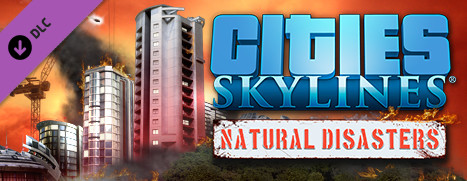
In Part 1 of this diary, I named a citizen Santa and set up a town around him, with the plan of trying to protect the jolly old elf from Cities: Skylines' Natural Disasters DLC. Also in Part 1, that town got wiped out by a meteor strike.
When I say wiped out, I mean it. It's almost entirely gone. Huge swaths of commercial and residential areas are now piles of rubble. My hulking Disaster Response Unit located just a block from Santa's house? It's been obliterated by the disaster. That means there's no one left alive to look for anyone left alive, and the people who are supposed to clean up the rubble are all buried under rubble. As mayor of Santa City, I can officially state that Christmas is cancelled.
But Santa did survive—somehow. His house sits on the very, very edge of the meteor's blast radius. I'm both happy and amazed that Santa's house is still standing, but there are two little problems. First, the house is on fire, and second, Santa is still inside. Despite the emergency shelter next door and the evacuation buses circling the block, Santa hasn't escaped to safety.
While I watch, waiting for fire trucks that never come, I notice Santa suddenly vanishes from the house. It's not elven magic or flying reindeer, he's simply moved out and into another house, on the other side of the city (I can keep tabs on him thanks to the handy Favorite Cims mod). Just in the St. Nick of time, too: his original house continues to burn a few moments longer, then collapses.
The aftermath of the meteor: 109 buildings destroyed, 449 citizens dead. What's left of the city is in major trouble. I have to clear ruined buildings and roads manually, and rebuild all my services, like police, fire, and schools. Not for the whole city, of course, just for the area surrounding Santa's new home. I also plop down a new Disaster Response Unit, right across the street from his new pad, which I name North Pole West.
While I'm slowly cleaning up, another meteor arrives. Thankfully, this one strikes the coast, where it only takes out some water lines and a wind turbine. Now I have two massive craters and a chasm from the earthquake. The map is covered with scars.
What's worse is that having rebuilt so many services to protect Santa, I'm now out of money, and I'm operating at a loss. I'm slashing budgets left and right, meaning that half my city is in a blackout from the disaster and the other half is in a blackout from a poorly funded power department. The problem is mostly utilities. All those water lines that aren't serving citizens anymore (because the citizens are dead) still require upkeep in the budget. To save the city I'm going to have to rip it apart, delete almost everything that costs me money, and start rebuilding slowly and efficiently.
I bulldoze, well, just about everything except a small sliver of residences and industrial areas. Every unneeded inch of water pipe is removed. As I cut off citizens from power and services, things get bad. Toilets overflow. Trucks can't make deliveries. Crime goes through the roof. Some asshole even commits a crime at the snow dump, which is a dump for snow. It's literally just a big box of snow! I could understand someone committing crime at a garbage dump (and someone is committing crime at the garbage dump, now that I look) because even garbage has a little bit of value. But a snow dump? That's desperation. Yet, my box of snow has attracted snow crimes.
Santa abruptly moves from his current house (which has no electricity and is overflowing with sewage and garbage) into a new one in the very small section of town that's still functioning properly. I name his house North Pole: New Beginnings, adding a smiley face because I'm feeling the need for optimism. Santa is 83 now, by the way, and I fear not long for this world.
It seems like the game won't throw disasters at you if you have a low population, which is good. It'll give me some time to rebuild. And I'm going to need that time. My population has plummeted to 113 people, meaning the corpses of the meteor strike now outnumber the living.
Thankfully, there's a Christmas miracle. I'm offered a bailout after going bankrupt. A cool $50,000 to rebuild the smoking crater of death that is Santa City. With this bit of cash, I slowly and carefully begin rebuilding. I'm not sure I can call it progress: the population remains at only a few hundred citizens, my budget is still shoestring, and the most activity I see on my chilly streets is a single donut truck making the rounds.
And, in sadder news, my original Santa has died at the age of 95. I watch as he's picked up and deposited in the cemetery, pour some eggnog on his grave, check to see his heir in is place, and get back to work.
Tomorrow, in Part 3: Can the town, and my new Santa, be saved?





